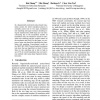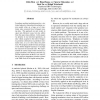110
click to vote
EMNLP
2009
14 years 10 months ago
2009
In a linguistically-motivated syntax-based translation system, the entire translation process is normally carried out in two steps, translation rule matching and target sentence d...
103
click to vote
EMNLP
2010
14 years 10 months ago
2010
In modern machine translation practice, a statistical phrasal or hierarchical translation system usually relies on a huge set of translation rules extracted from bi-lingual traini...
99
Voted
ACL
2010
14 years 10 months ago
2010
Tree-to-string translation rules are widely used in linguistically syntax-based statistical machine translation systems. In this paper, we propose to use deep syntactic informatio...
120
click to vote
GG
2010
Springer
14 years 11 months ago
2010
Springer
Abstract. Triple Graph Grammars (TGGs) are a well-established concept for the specification of model transformations. In previous work we have formalized and analyzed already cruc...
117
Voted
COLING
2002
15 years 12 days ago
2002
A number of machine translation systems based on the learning algorithms are presented. These methods acquire translation rules from pairs of similar sentences in a bilingual text...
140
Voted
ACL
1998
15 years 1 months ago
1998
This paper proposes a learning method of translation rules from parallel corpora. This method applies the maximum entropy principle to a probabilistic model of translation rules. ...
105
click to vote
ER
2008
Springer
15 years 2 months ago
2008
Springer
Abstract. The alignment of different ontologies requires the specification, representation and execution of translation rules. The rules need to integrate translations at the lexic...
105
click to vote
WAIM
2005
Springer
15 years 6 months ago
2005
Springer
Monitoring the real-time status of voluntary nodes is a basic task of Quality of Services (QoS) management in grid. The heterogeneity of distributed host resources is an obvious ob...



